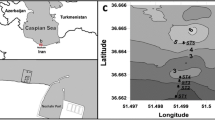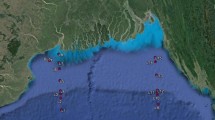Abstract
Wave modeling was performed in the German Bight of the North Sea during November 2002, using the spectral wave models, namely the K-model and Simulating WAves Nearshore (SWAN), both developed for applications in environments of shallow water depths. These models mainly differ with respect to their dissipation source term expressions and in exclusion or inclusion of nonlinear wave–wave interactions. The K-model uses nonlinear dissipation and bottom dissipation, and neglects quadruplet wave–wave interaction whereas, SWAN includes, besides bottom dissipation, dissipation by white-capping and depth induced wave breaking and triad wave–wave interaction. The boundary spectra were extracted from the WAM model results of a North Sea hindcast of the HIPOCAS project, wind fields, tidal current and water level variations from the results of models used in the Belawatt project. The purpose of this study was to test the performance of both wave models to see whether they were able to predict near-shore wave conditions accurately. The runs were performed with and without tidal current and level variations to determine their effect on the waves. Comparisons of model results with buoy measurements show that taking into account tides and currents improve the spectral shape especially in areas of high current speeds. Whereas SWAN performed better in terms of spectral shape, especially in case of two peaked spectra, the K-model showed better results in terms of integrated parameters.
















Similar content being viewed by others
References
Arcilla AS, Roelvink JA, O’Conner BA, Reniers A, Jimenez JA (1994) The Delta Flume ’93 experiment. Coastal Dynamics 1994, ASCE, pp 488–502
Battjes JA, Janssen JPFM (1978) Energy loss and set-up due to breaking of random waves. In: Proceeding of 16th international conference on coastal engineering, ASCE, pp 569–587
Booij N, Ris RC, Holthuijsen LH (1999) A third-generation wave model for coastal regions. 1. Model description and validation. J Geophys Res 104(C4):7649–7666
Casulli V, Cattani E (1994) Stability, accuracy and efficiency of a semi-implicit method for three-dimensional shallow water flow. Comput Math Appl 27:99–112
Casulli V, Cheng RT (1992) Semi-implicit finite difference methods for three dimensional shallow water flow. Int J Numer Methods Fluids 15:629–648
Cavaleri L, Rizzoli PM (198) Wind wave prediction in shallow water—theory and application. J Geophys Res 86:10961–10973
Eldeberky Y (1996) Nonlinear transformation of wave spectra in the nearshore zone. PhD Thesis, Delft University of Technology, Department of Civil Engineering, The Netherlands
Eldeberky Y, Battjes JA (1995) Parameterization of triad interactions in wave energy models. In: Proceedings of coastal dynamics conference’95, Gdansk, pp 140–148
Eppel DP, Kapitza H, Onken R, Pleskatchevski A, Puls W, Riethmueller R, Vaessen B (2003) BELAWATT-Watthydrodynamik: Die hydrodynamische Belastung von Wattgebieten. GKSS Research Center Publication, Germany
Günther H, Rosenthal W (1995) A wave model with a non-linear dissipation source function. In: Proceedings of the 4th international workshop on wave hindcasting and forecasting, Banff
Günther H, Hasselmann S, Janssen PAEM (1992) The WAM Model cycle-4.0. User manual. Deutsches Klimarechenzentrum Hamburg, Technical Report No. 4
Hasselmann K, Barnett TP, Bouws E, Carlson H, Cartwright DE, Enke K, Ewing JA, Gienapp H, Hasselmann DE, Krusemann P, Meerburg A, Müller P, Olbers DJ, Richter K, Sell W, Walden H (1973) Measurements of wind-wave growth and swell decay during the Joint North Sea Wave Project (JONSWAP). Deutsche Hydrographische Zeitschrift Suppl A8(12):95
Hasselmann S, Hasselmann K, Allender JH, Barnett TP (1985) Computations and parameterizations of the nonlinear energy transfer in a gravity wave spectrum. Part II: parameterizations of the nonlinear transfer for application in wave models. J Phys Oceanogr 15(11):1378–1391
Holthuijsen LH, Booij N, Ris RC, Haagsma IJG, Kieftenburg ATMM, Kriezi EE, Zijlema M, van der Westhuysen AJ (2004) SWAN Cycle III Version 40.31 User Manual. Delft University of Technology, The Netherlands.
Komen GJ, Cavaleri L, Donelan M, Hasselmann K, Hasselmann S, Janssen PAEM (1994) Dynamics and Modelling of Ocean Waves. Cambridge University Press, London
Lin W, Sanford LP, Suttles SE (2002) Wave measurement and modeling in Chesapeake Bay. Cont Shelf Res 22:2673–2686
Luo W, Sclavo M (1997) Improvement of the third generation WAM model (cycle-4) for applications in the near shore regions. Proudman Oceanographic Laboratory. Internal document No. 116
Monbaliu J, Padilla-Hernandez R, Hargreaves JC, Albiach JCC, Luo W, Sclavo W, Günther H (2000) The spectral wave model, WAM, adapted for applications with high spatial resolution. Coast Eng 41:41– 62
Ris RC, Holthuijsen LH, Booij N (1999) A third-generation wave model for coastal regions. 2.Verification. J Geophys Res 104(C4):7667–7681
Rosenthal W (1989) Derivation of Phillips α-parameter from turbulent diffusion as a damping mechanism. In: Komen GJ, Oost WA (eds) Radar Scattering from Modulated Wind Waves. Kluwer, Dordrecht, pp 81–88
Schneggenburger C, Günther H, Rosenthal W (1997) Shallow water wave modelling with nonlinear dissipation. Deutsche Hydrographische Zeitschrift 49:431–444
Schneggenburger C, Günther H, Rosenthal W (2000) Spectral wave modelling with non-linear dissipation: validation and applications in a coastal tidal environment. Coast Eng 41:201–235
Tolman HL (1991) A third-generation model for wind waves on slowly varying, unsteady and inhomogeneous depths and currents. J Phys Oceanogr 21:782–797
Tolman HL, Chalikov DV (1996) Source terms in a third-generation wind wave model. J Phys Oceanogr 26:2497–2518
WAMDI Group, Hasselmann S, Hasselmann K, Bauer E, Janssen PAEM, Komen GJ, Bertotti L, Lionello P, Guillaume A, Cardone VC, Greenwood JA, Reistad M, Yambresky L, Ewing JA (1988) The WAM model—a third generation ocean wave prediction model. J Geophys Res 18:1775–1810
Weisse R, Gayer G (2000) An approach towards a 40-year high-resolution wave hindcast for the Southern North Sea. In: Proceedings of 6th international workshop on wave hindcasting and forecasting, Monterey, pp 6–10
Wornom SF, Welsh DJS, Bedford KW (2001) On coupling of SWAN and WAM wave models for accurate nearshore wave predictions. Coast Eng J 43(3):161–201
Wornom SF, Welsh DJS, Bedford KW (2002) The effect of wave propagation scheme on nearshore wave predictions. Coast Eng J 44 (4):359–371
Acknowledgements
The authors are indebted to Dr. Wolfgang Rosenthal for many clarifying discussions, and Dr. Harmut Kapitza, Dr. Dieter Eppel and Dr. Walter Puls for their support by providing the hydrodynamical model, bathymetry and boundary data. The authors would also like to thank Dr. Marcel Zijlema of the SWAN group at Delft University of Technology, for his assistance. This work was performed as part of a Ph.D. program supported by the Iranian Ministry of science, research and technology and the GKSS Research Center, Geesthacht, Germany. Corresponding financial and scientific support is gratefully acknowledged.
Author information
Authors and Affiliations
Corresponding author
Additional information
Responsible Editor: Hans Burchard
Rights and permissions
About this article
Cite this article
Moghimi, S., Gayer, G., Günther, H. et al. Application of third generation shallow water wave models in a tidal environment. Ocean Dynamics 55, 10–27 (2005). https://doi.org/10.1007/s10236-005-0108-0
Received:
Accepted:
Published:
Issue Date:
DOI: https://doi.org/10.1007/s10236-005-0108-0




